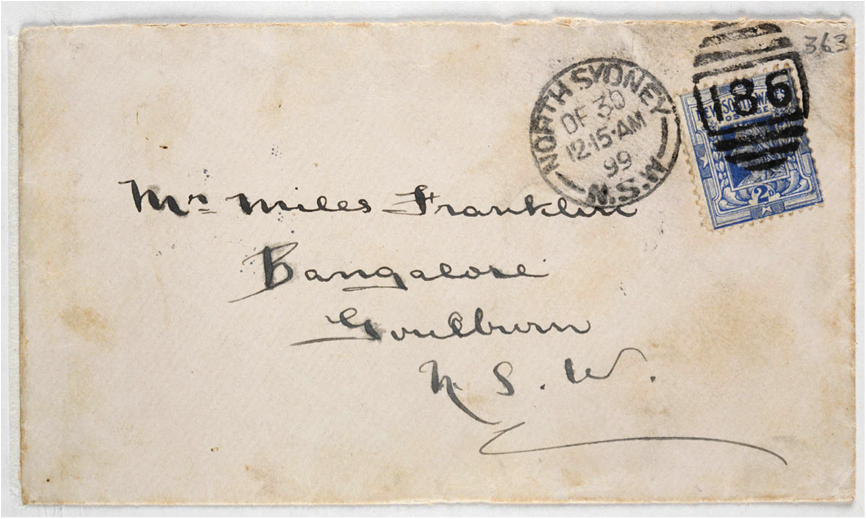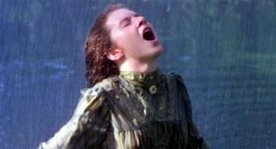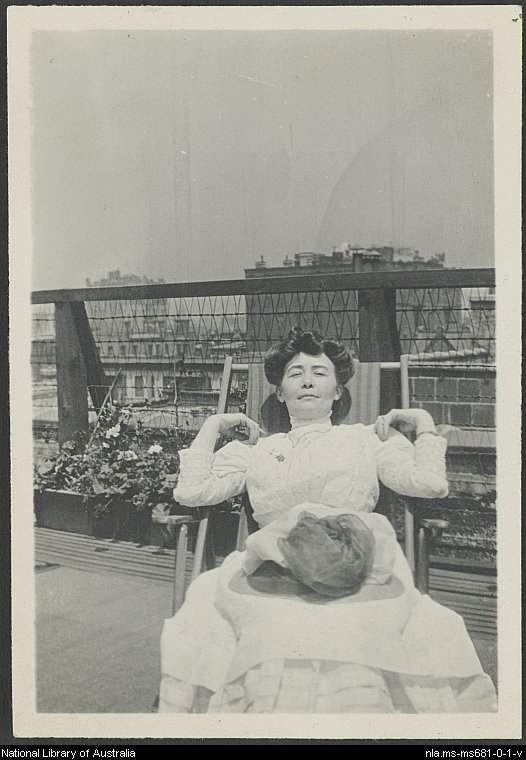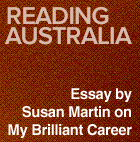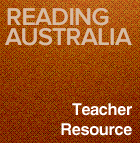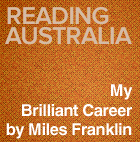AustLit
-
My Brilliant Career tells the story of Sybylla Melvyn, a strong-willed young woman of the 1890s growing up in the Goulburn area of New South Wales and longing to be a writer. The story was influenced by the experiences of its author Miles Franklin (born Stella Franklin), who grew up in the area. Franklin bequeathed her papers to the Mitchell Library at the State Library of New South Wales, and much of the archive is available online. Franklin has left a remarkable legacy not only in terms of her writing, her archive, and her fascinating life, but also in the establishment of the Miles Franklin Literary Award.
This trail collects a range of items to enhance readers' engagement with My Brilliant Career.
– Part One looks at Miles Franklin's world.
– Part Two looks at the impact of feminism on the novel's adaptation into film.
– Part Three examines gender, ideas of literary value and literary awards.
– Parts Four and Five give links to scholarly articles, reviews, and other further reading. Some of these critical works and other resources are available to read online.
Click the hyperlinks in the citations below to be taken to the full text.
-
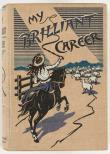 Cover image from first edition.See full AustLit entry
Cover image from first edition.See full AustLit entry'My Brilliant Career was written by Stella Franklin (1879-1954) when she was just nineteen years old. The novel struggled to find an Australian publisher, but was published in London and Edinburgh in 1901 after receiving an endorsement from Henry Lawson. Although Franklin wrote under the pseudonym 'Miles Franklin', Lawson’s preface makes it clear that Franklin is, as Lawson puts it 'a girl.'
'The novel relates the story of Sybylla Melvyn, a strong-willed young woman of the 1890s growing up in the Goulburn area of New South Wales and longing to be a writer.
(...more)Explore the AustLit record for My Brilliant Career to discover the complex history of the book and its author.
-
See full AustLit entry
Miles Franklin was born in 1879 near Tumut, New South Wales. A fifth-generation Australian, Franklin grew up on grazing properties run by her family in the Monaro region. A decline in profits and the increasingly poorer properties taken up by the Franklin family were a major influence on the young Miles, an influence that is reflected in her fiction. At nineteen she wrote My Brilliant Career, the novel for which she is most admired. But the novel remained unpublished until 1901 when Henry Lawson supported its publication in London by Blackwood.
Explore the AustLit author record for Miles Franklin to discover more about her life and her other works.
-
See full AustLit entry
This essay, an introduction to My Brilliant Career, was written for the Reading Australia project. It discusses the continuing relevance of the novel, and its representations of romance, a kind of 'anti-romance,' and reading. It also discusses the novel's depiction of bush life and drought.
(...more)Available online at Reading Australia.
-
Miles Franklin's Papers Online at the State Library of New South Wales
The State Library of New South Wales has digitised many items pertaining to Miles Franklin’s life and career and made them available online. The items include a contract with her literary agent, letters from her publisher, and diaries. They also include letters that Franklin exchanged with Henry Lawson, an early supporter of her work. For example, the collection ‘Miles Franklin - Papers, 1841-1954’ contains an envelope addressed to ‘Mr Miles Franklin’ from 30 December 1899, which held Lawson’s first letter to the young author. Also digitised is the letter itself, in which Lawson writes: ‘Dear ‘Miles Franklin,’ Received your M.S. this morning and have more than ‘skimmed’ through it already. Will you write and tell me who and what you really are? man or woman? and something about yourself?’
-
'Evidence from the novel, the Franklin Papers at the Mitchell Library, and the wonderfully informative Goulburn Evening Post indicates that while Franklin always insisted "the novel is not my life", both she and it owed a good deal to 1890s Goulburn', particularly her teacher Miss Mae Gillespie and journalist Thomas J. Hebblewhite (Jill Roe, Macquarie University News, September 2001, p.6) (...more)See full AustLit entry
Roe, Jill. '1890s Goulburn and My Brilliant Career.' Australian Literary Studies 20.4 (2002): 359-369.
-
The Goulburn Evening Penny Post mentions Franklin’s ‘insignificant’ looks in one of its columns. An earlier reviewer for the same newspaper had commented: ‘I do not attempt to judge, nor do I know if it is to be taken as an autobiography; if so the question arises, Is it in good taste to depict one's parents in such an unpleasant light, even for the purpose of fiction?’ (13 May 1902). The tone of these comments may well result from Franklin’s having lived in Goulburn and setting the book in the area.
-
By searching the NLA’s Trove service for digitised newspapers, it is possible to read the 1901 reviews of My Brilliant Career. The Sydney Morning Herald review of 28 September 1901 remarks that: ‘The heroine of the story (which by the way is prefaced by a few words from the pen of Mr. Henry Lawson) is not a person whose acquaintance in the flesh it would be desirable to make.’ The reviewer suggests that Sybylla ‘has a distinctly unpleasant way of asserting herself and her goodness,’ and is eager to state that it ‘would be matter for regret if she […] could possibly be taken as a type of Australian bush girl. Bold, forward, and selfish Sybylla is the sort of girl that is happily rare in Australia.’
-
Gillian Armstrong’s Film Version of My Brilliant Career
The film adaptation of My Brilliant Career (1979) was the first feature directed by Gillian Armstrong, who would go on to be one of Australia’s preeminent directors. As Australian Screen points out, Sybylla Melvyn ‘came to life on film in the same year as the road warrior in the masculine fantasy Mad Max.’ It is no coincidence that the film was made in the 1970s, a period strongly influenced by second-wave feminism.
Clips from Armstrong’s film can be viewed at Australian Screen, the website of the National Film and Sound Archive.
-
Jan Chapman writes about Armstrong, My Brilliant Career, and the early days of the Australian film revival in her article ‘Some Significant Women in Australian Film.’ Susan Sheridan in her academic article 'My Brilliant Career: The Career of the Career' argues that ‘it was the film that probably made the novel's international publication possible’ because of the renewed interest that it sparked in the book.
Chapman, Jan. 'Some Significant Women in Australian Film: A Celebration and a Cautionary Tale.' Senses of Cinema Sep-Oct 2002. Online here. Sighted 06/12/2013.
Sheridan, Susan. 'My Brilliant Career: The Career of the Career.' Australian Literary Studies 20.4 2002.
-
It is worth noting that the 1970s also saw the founding in Melbourne of the feminist press Sybylla—named, of course, after the protagonist of My Brilliant Career.
-
In her will, Franklin set aside funds for the establishment of the Miles Franklin Literary Award, which is one of Australia’s most prestigious literary awards. The first winner, in 1957, was Patrick White for his novel Voss. By early 2011, the award had been conferred 54 times, but only ten of the recipients had been women. (One of them, Thea Astley, won four times.)
-
The Stella Prize
As a response to concerns about the invisibility of women in Australian literary culture, the Stella Prize was established to award excellence in fiction and non-fiction by Australian women writers. It was named for Franklin’s (often forgotten) first name. The inaugural winner of the Stella Prize in 2013 was Carrie Tiffany for her novel Mateship with Birds.
-
See full AustLit entry
'Stella Miles Franklin did not want readers of her novel My Brilliant Career to assume that its author was a woman. She wrote to its publishers, asking for the 'Miss' to be removed: she intended readers to believe it to be written by 'a bald-headed seer of the sterner sex'. When Henry Lawson first read it he was flummoxed by the gender of the author. He wrote to Franklin, asking her: 'Will you write and tell me what your really are? Man or woman?' This confusion is nowhere apparent in the preface he wrote for the novel's publication in 1901.
(...more)Commenting on the reception of women’s writing and notions of literary value, Julieanne Lamond writes in her 2011 article ‘Stella vs Miles':
In reprising these arguments about the fate of women in the Australian literary tradition, I don’t want to suggest a deliberate project on the part of any of the judges of Australian literary prizes to occlude women’s writing. Rather, I want to pose the question of how far, in the difficult decisions about the relative merit of books in the running for such prizes, this older association between masculinity, nationhood and genre comes into play, especially in the case of a prize so explicitly bounded by the nation as the Miles Franklin Award. In particular, I wonder about what Sheridan calls the ‘scarcely noticeable sediment of common sense about what constitutes literary value’ distinguishing between different literary forms and genres in the Australian context and how far this has influenced the gender balance of our awards and our literary pages. (38)
Lamond, Julieanne. ‘Stella vs Miles: Women Writers and Literary Value in Australia.’ Meanjin 70.3 (2011): 32-39. Online. Sighted 06/12/2013.
-
See full AustLit entry
Sonya Hartnett writes about the reception of My Brilliant Career, the poor royalties that Franklin received, and how the book might have fared differently today. While conditions for writers are in many ways much improved, Hartnett argues, the book would have its future 'hobbled' because it would be designated as Young Adult literature.
(...more)Hartnett, Sonya. 'A Bold Life Reaches across Time and Space.' Upfront 16.1 (2004): 3-5. Online. Sighted 06/12/2013.
-
See full AustLit entry
In this introduction to the Text Classics re-issue of My Brilliant Career, Jennifer Byrne writes about Sybylla Melvyn's fury and wonders if Miles Franklin had the sense that she was living in the wrong time. Byrne also discusses the history of the book's reception and the changes wrought by feminism.
(...more)Byrne, Jennifer. 'The Despair of the Household.' Sydney Morning Herald 14 Apr. 2012. Online at http://www.smh.com.au/entertainment/books/the-despair-of-the-household-20120413-1wya8.html. Sighted 06/12/2013.
-
See full AustLit entry
This issue of Australian Literary Studies has a special focus on Miles Franklin and My Brilliant Career.
(...more)Australian Literary Studies 20.4 (2002).
-
-
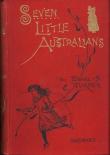 See full AustLit entry
See full AustLit entry'Without doubt Judy was the worst of the seven, probably because she was the cleverest.'
'Her father, Captain Woolcot, found his vivacious, cheeky daughter impossible – but seven children were really too much for him and most of the time they ran wild at their rambling riverside home, Misrule.
'Step inside and meet them all – dreamy Meg, and Pip, daring Judy, naughty Bunty, Nell, Baby and the youngest, 'the General'. Come and share in their lives, their laughter and their tears.
(...more)Turner, Ethel. Seven Little Australians. London and Melbourne: Ward, Lock and Bowden, 1894. Online at http://www.gutenberg.org/ebooks/4731. Sighted 06/12/2013.
-
See full AustLit entry
'A story of friendship and love set in the goldfields of Western Australia in the 1890s. The determined Sally Gough braves hardship and danger in this classic tale of pioneering Australia.' (Source: Bookseller's website.)
(...more)Prichard, Katherine Susannah. The Roaring Nineties: A Story of the Goldfields in Western Australia. London and Sydney: Jonathan Cape, 1946.
-
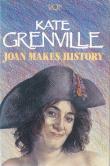 This image has been sourced from online.See full AustLit entry
This image has been sourced from online.See full AustLit entryAustralia's history retold through the eyes of Joan, a woman who has never rated a mention in the school books. Joan leads many lives: she is a wife and mother of no great distinction, but in the life of her imagination she is present at all the big moments of Australia's past. (Source: Trove)
(...more)Grenville, Kate. Joan Makes History. St Lucia: University of Queensland Press, 1988.
You might be interested in...



